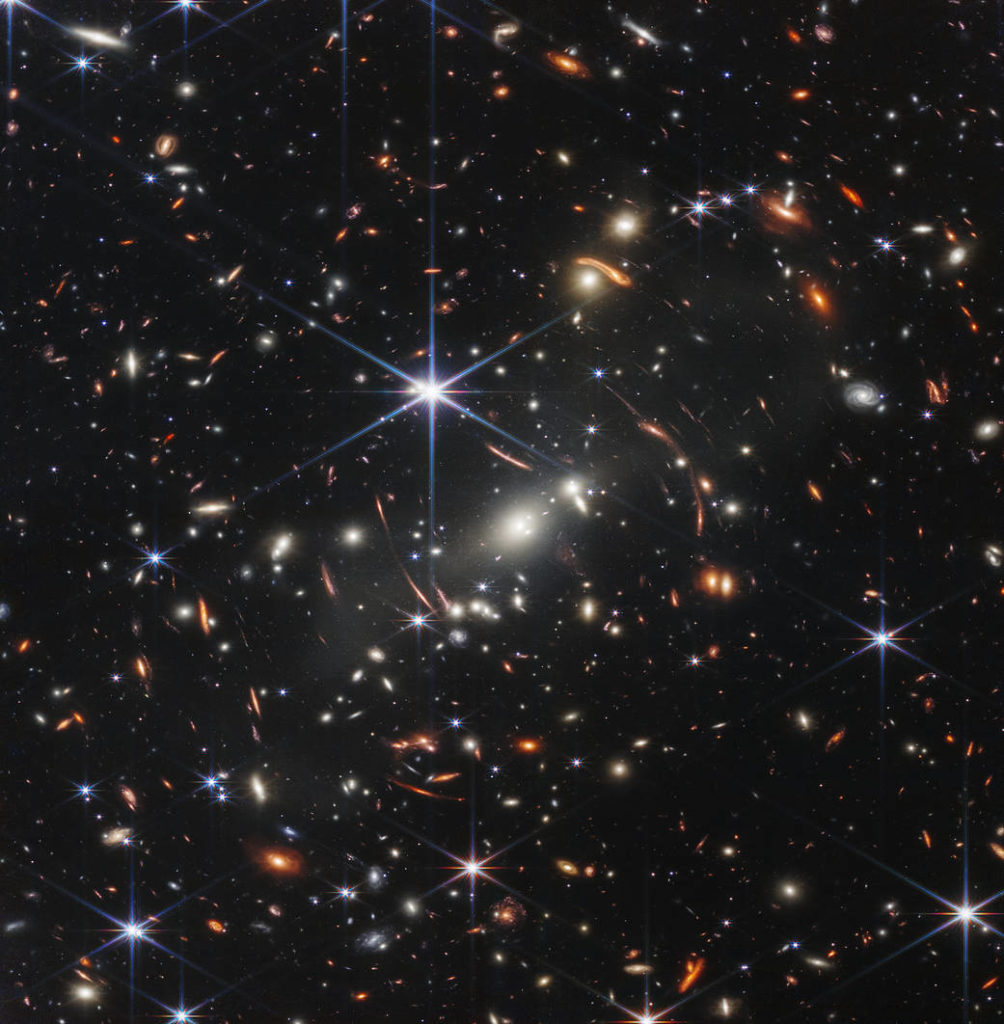
I have seen the burden God has laid on the human race. He has made everything beautiful in its time. He has also set eternity in the human heart; yetno one can fathom what God has done from beginning to end. – Ecclesiastes 3:10-11 (NIV)
This week NASA released early images from the Webb telescope, including the one above, of the galaxy cluster SMACS 0723 (aka Webb’s First Deep Field). The images are truly beautiful and at the same time tug at the eternity set in our hearts.
An excerpt from NASA’s accompanying description of SMACS 0723:
Webb’s image is approximately the size of a grain of sand held at arm’s length, a tiny sliver of the vast universe. The combined mass of this galaxy cluster acts as a gravitational lens, magnifying more distant galaxies, including some seen when the universe was less than a billion years old. This deep field, taken by Webb’s Near-Infrared Camera (NIRCam), is a composite made from images at different wavelengths, totaling 12.5 hours – achieving depths at infrared wavelengths beyond the Hubble Space Telescope’s deepest fields, which took weeks. And this is only the beginning. Researchers will continue to use Webb to take longer exposures, revealing more of our vast universe.
Wow. Absolutely. Breathtaking.
From the language of this NASA narrative, it’s only a small step to the metaphor of a selfie. In such an analog, it’s important to realize the human race played an important but nevertheless supporting role. We merely manufactured the (Webb) “cellphone.” Webb’s orbit itself might be considered the “selfie stick.” The selfie’s subject is of course the universe writ large.
Unlike ordinary selfies, which capture a single instant, this one also embodies a time span – a huge one, approaching the full age of the universe. Light from the distant objects originated more than ten billion years ago; light from the closest objects a mere fraction of that, much closer to the present day, but many cases still more ancient than the whole of human history.
Otherwise, there are several similarities. For example, like most selfies, this one offers a narrow field of view, only hinting at a much larger context. Most selfies are celebratory, and so is this one. It’s the culmination of decades of planning and technological achievement. (This author remembers a visit to Ball Aerospace in Colorado years ago that included quick side trip to a cavernous room where the Webb mirrors and instrument were being assembled; to be seeing Webb’s first images this week has been an exciting experience – and that’s from the viewpoint of a mere bystander. Can’t begin to imagine the profound emotions that must be running through those who actually conceptualized, built, and deployed Webb, along with the gaggle of scientists who are only just now beginning to examine and analyze the outputs. What a head rush!)
We all know from personal experience that some selfies age better than others. Many capture a special moment, are shared on social media, but we think of them no more. Others capture a moment or commemorate relationships that grow more precious with time. We revisit them frequently, re-post them on anniversaries, etc. The long-term impact of Webb’s initial images will depend on subsequent data and discoveries resulting from the research, but also, like other selfies, on the trajectory of relationships that bind the human race. Should society grow more inclusive, equitable, and generally fairer and more peaceable, these and future images will grow in power and influence. They’ll shape and ennoble our human self-image and understanding of how we fit in to the cosmos. If instead the current tears in the world’s social fabric be exacerbated by war, terrorism, economic exploitation, failures to cope with challenges such as pandemic and climate change, then any of the current wonder occasioned by this scientific and technological accomplishment will wane in the face of growing chaos.
Which brings me to the above excerpt from the Old Testament Book of Ecclesiastes. To me it seems as relevant today as it was a couple of thousand years ago. On the one hand, we might imagine that our view of eternity today is far more developed and nuanced than it had been back then, especially given present understanding of the age of the universe, and the physical processes at work throughout. On the other, as our knowledge has been refined, new uncertainties have emerged – and not just in the details. Today we rely on fudge factors like dark matter (some 85% of matter in the universe?) and dark energy (some 70% of the matter-energy of the universe), neither of which has been satisfactorily detected, let alone studied, to make certain cosmological sums and observed phenomena work out. It might seem that science still has some way to go.
These are large uncertainties. To see this, suppose you took your car to the dealer’s for a muffler replacement, expecting a bill for labor and parts of $300. At jobs end, you were presented a bill for $2000. When you protested, the dealer said, “you’ve forgotten about the dark surcharges, which are 85% of the total bill.” (So of course you apologize: “silly me! I forgot all about that!”)
In this moment of scientific and technological achievement, there’s still plenty of room for humility, for a sense of wonder, and for eagerness to get to the work remaining.
Thanks again, NASA! Once again you’ve awed us, humbled us, elevated our sights, and at the same time given us reason to draw closer together.
